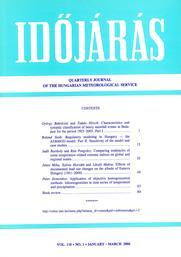IDŐJÁRÁS - angol nyelvű folyóirat
Vol. 110, No. 1 * Pages 1–89 * January - March 2006
 |
|
 letöltés [pdf: 37524 KB]
letöltés [pdf: 37524 KB]
Characteristics and synoptic classification of heavy snowfall events in Budapest for the period 1953–2003 Part I
Babolcsai György, Hirsch Tamás
idojaras.2006.1.1 (p. 1–)
Babolcsai György, Hirsch Tamás
idojaras.2006.1.1 (p. 1–)
Regulatory modeling in Hungary — the AERMOD model. Part II. Sensitivity of the model and case studies
Steib Roland
idojaras.2006.1.2 (p. 15–)
Steib Roland
idojaras.2006.1.2 (p. 15–)
Comparing tendencies of some temperature related extreme indices on global and regional scales
Bartholy Judit, Pongrácz Rita
idojaras.2006.1.3 (p. 35–)
Bartholy Judit, Pongrácz Rita
idojaras.2006.1.3 (p. 35–)
Effects of documented land use changes on the albedo of Eastern Hungary (1951–2000)
Mika János; Horváth Szilvia; Makra László
idojaras.2006.1.4 (p. 49–)
Mika János; Horváth Szilvia; Makra László
idojaras.2006.1.4 (p. 49–)
Application of objective homogenization methods: Inhomogeneities in time series of temperature and precipitation
Domonkos Péter
idojaras.2006.1.5 (p. 63–)
Domonkos Péter
idojaras.2006.1.5 (p. 63–)
IDŐJÁRÁS folyóirat

Az IDŐJÁRÁS a HungaroMet Nonprofit Zrt. negyedévenként megjelenő angol nyelvű folyóirata
Megrendelhető a journal.idojaras@met.hu címen.
A szerzőknek szánt útmutató itt olvasható.
Megrendelhető a journal.idojaras@met.hu címen.
A szerzőknek szánt útmutató itt olvasható.









